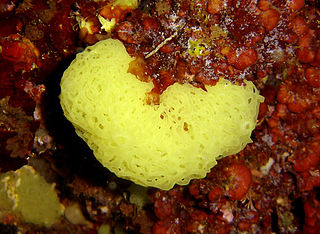
Leucospermum is a genus of evergreen upright, sometimes creeping shrubs that is assigned to the Proteaceae, with currently forty-eight known species. Almost all species are easily recognised as Leucospermum because of the long protruding styles with a thickened pollen-presenter, which jointly give the flower head the appearance of a pincushion, its common name. Pincushions can be found in South Africa, Swaziland, Zimbabwe and Mozambique.

Clathrina is a genus of calcareous sponge in the family Clathrinidae. Several species formerly in Clathrina were transferred to the newly erected genera Arturia, Ernstia, Borojevia, and Brattegardia in 2013. The name is derived from the Latin word "clathratus" meaning "latticed".
Arturia africana is a species of calcareous sponge from South Africa.
Borojevia brasiliensis is a species of calcareous sponge from Brazil, from which the species' name is derived.
Borojevia cerebrum is a species of calcareous sponge from the Mediterranean Sea. The species name refers to the brain-like appearance of the sponge.
Clathrina ceylonensis is a species of calcareous sponge from Sri Lanka. The species name is derived from Ceylon, the former name of Sri Lanka.
Clathrina chrysea is a species of calcareous sponge from New Caledonia. The species epithet refers to the light yellow colour of the sponge.
Clathrina clara is a species of calcareous sponge from India. The name refers to the clear, bright surface of the sponge.
Clathrina cylindractina is a species of calcareous sponge from Brazil. The species is named after the cylindrical-shaped actines the sponge possesses.
Clathrina helveola is a species of calcareous sponge from Australia. The species name means "pale yellow" in Latin and refers to the species' colouration.
Clathrina heronensis is a species of calcareous sponge from Australia. The species is named after Heron Island where the holotype was collected.
Arturia hirsuta is a species of calcareous sponge from South Africa. The name refers to the hispid surface of the sponge.
Clathrina hispanica is a species of calcareous sponge from Spain. The species is named after the country of Spain, where it was discovered.
Clathrina hondurensis is a species of calcareous sponge from Belize. The species is named for British Honduras, the former name of Belize, at the time the holotype was collected in 1935.
Clathrina laminoclathrata is a species of calcareous sponge from Australia. The species name is in reference to its unusual lamina.
Clathrina luteoculcitella is a species of calcareous sponge from Australia. The species name means "yellow pillow" and refers to the appearance of the cormus.
Arturia sueziana is a species of calcareous sponge from Egypt. The species is named after the Egyptian city of Suez where the holotype was discovered.
Arturia tenuipilosa is a species of calcareous sponge from Sri Lanka. The name refers to the very thin, hair-like oxea present in this species.
Borojevia tetrapodifera is a species of calcareous sponge from New Zealand. The species is named after the presence of tetrapods, the only Clathrinid sponge known to possess such spicules.
Arturia is a genus of calcareous sponge in the family Clathrinidae which contains 14 species. It is named after Arthur Dendy, a prominent researcher of calcareous sponges. It was renamed Arturia in 2017 because the name Arthuria was already assigned to a genus of molluscs.

